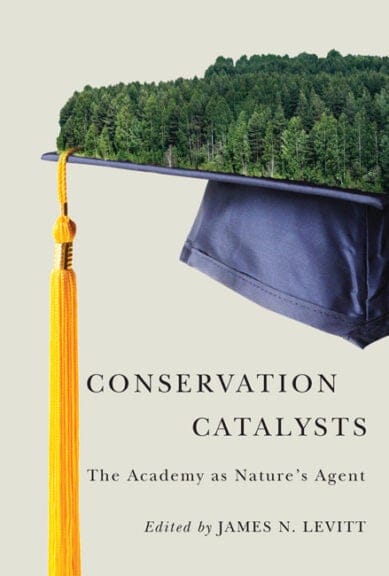Books

Conservation Catalysts
The Academy as Nature’s Agent
Edited by James N. Levitt with a foreword by Stephen Woodley
November 2014, English
Lincoln Institute of Land Policy
“We can gain encouragement from the coalition of groups that have rallied together to promote conservation and embrace connectivity: universities, environmental groups, land trusts, churches, and private corporations are leading the way. To succeed in conserving our natural heritage for many generations to come, we need them all. This book is about the need for new solutions and the groups that are making solutions happen. It is a message of hope.”
— Stephen Woodley, Co-Chair, International Union for the Conservation of Nature’s WCPA-SSC Task Force on Biodiversity and Protected Areas
This volume collects more than a dozen firsthand accounts of how conservationists at academic institutions are contending with biodiversity loss and climate change. Readers will learn how to protect wildlife habitats, improve water quality, build sustainable economies, and upgrade public amenities around the world.
About the Editor
James N. Levitt is the associate director of Land Conservation Programs at the Lincoln Institute of Land Policy and director of the program on conservation innovation at the Harvard Forest, Harvard University, in Petersham, Massachusetts.
Reviews
“Jim Levitt and his colleagues show how universities and research stations are sparking critical innovations in the field of land conservation. These institutions are creating the tools to accelerate the pace of land protection across large and complex landscapes.”
— Rand Wentworth, President, Land Trust Alliance
“Land conservation requires continual infusions of new resources and young talent. Conservation Catalysts describes the exciting efforts to link research, teaching, convening, and the work of university students with on-the-ground conservation efforts. Such initiatives offer a promising path forward for enhancing society's capacity to manage lands sustainably, at scale, and across generations.”
— Bradford Gentry, Professor in the Practice, Yale School of Forestry and Environmental Studies; Co-Director, Yale Center for Business and the Environment
Table of Contents
Part I: Regional Conservation Initiatives
1. The Wildlands and Woodlands Initiative of the Harvard Forest, Harvard University
David Foster, David Kittredge, Brian Donahue, Kathy Fallon Lambert, Clarisse Hart, and James N. Levitt
2. The University of Montana, Missoula: A Campus with an Ecosystem
Gary M. Tabor, Matthew McKinney, and Perry Brown
3. Research Networks and Large-Landscape Conservation and Restoration: The Case of the Colorado River Delta
Karl Flessa
Part II: Biodiversity Conservation at the Landscape Scale
4. Saving the Florida Scrub Ecosystem: Translating Science into Conservation Action
Hilary M. Swain and Patricia A. Martin
5. Catalyzing Large Landscape Conservation in Canada’s Boreal Systems: The BEACONs Project Experience
Fiona K. A. Schmiegelow, Steven G. Cumming, Kimberly A. Lisgo, Shawn J. Leroux, and Meg A. Krawchuk
6. Working Landscapes and the Western Hemisphere Jaguar Network
Joe Figel
Part III: Sustainable Development and Land Conservation
7. The Kenyon College Land Conservation Initiative
Douglas L. Givens
8. The Quiet Corner Initiative at the Yale School of Forestry & Environmental Studies
Mary Tyrrell, Matthew Fried, Mark Ashton, and Richard Campbell
9. Alternative Futures Modeling in Maine’s Penobscot River Watershed: Forging a Regional Identity for River Restoration
Robert J. Lilieholm, Christopher S. Cronan, Michelle L. Johnson, Spencer R. Meyer, and Dave Owen
10. The Mara-Serengeti Ecosystem and Greater Maasailand: Building the Role of Local Leaders, Institutions, and Communities
Robin S. Reid, Dickson Kaelo, David K. Nkedianye, Patti Kristjanson, Mohammed Y. Said, Kathleen A. Galvin, and Isabella Gambill
Part IV: Law, Policy, and Organization
11. Law as a Cornerstone of Conservation Policy: United States Law Schools as Conservation Catalysts
Federico Cheever and Nancy A. McLaughlin
12. A Walk on the Beach: Catalyzing the Conservation of Victoria’s Coast
Geoff Wescott
13. Karukinka: A New Model for Conservation
Guillermo Donoso
14. Conservation Easements as a Land Conservation Strategy in Trinidad & Tobago
Karena Mahung
Part V: The Contribution of the Humanities
15. Colorado College’s Large Landscape Conservation Strategy to Save the Colorado River Basin
Alex Suber
16. Body of Bark
Caroline Harvey
17. The Drowning Fish: Large Landscapes and the Burden of Significance
Blair Braverman
18. A Letter from Alice Van Evera
Keywords
Conservation, Environment, Environmental Management, Environmental Planning, Forest Land, Land Trusts, Natural Resources, New England, Open Space
